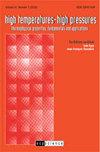电磁悬浮实验中紊流和过渡流的可及范围
IF 0.6
4区 工程技术
Q4 Engineering
引用次数: 0
摘要
在失重条件下的电磁悬浮在测量金属熔体的热物理性质和研究金属熔体的凝固方面显示出巨大的效用。液态金属样品的内部流动是许多此类实验的关键参数。例如,样品中的湍流阻碍了振荡液滴法测量粘度,因为测量的振荡阻尼是流动的特性,而不是流体的特性。在凝固过程中,已经证明内部流动改变了不锈钢亚稳相的寿命,在实验可达到的范围内几乎改变了两个数量级。在这些实验中,通过CFD模型对流动进行了量化;然而,这些模型需要流是层流还是湍流作为实验输入。迄今为止,对EML向湍流过渡的唯一研究来自1997年在航天飞机上的MSL-1 TEMPUS上的钯硅合金实验。在每个熔化循环中,示踪粒子揭示了流动的层流或湍流性质。然而,这种现象只是在飞行后才被注意到和检查,因此观测只能用于非常狭窄的条件范围。由于这些结果是唯一可用的,它们被大胆地外推到远离原始实验的条件下。此外,虽然来自锗的测量证据表明,定位器本身可以驱动湍流,但没有可用的测量数据表明定位器主导的流动中的湍流过渡。在更基本的层面上,EML流受到液滴自由表面的约束,就像内部流的壁一样。然而,与内部流动中的壁面不同,EML液滴的自由表面不支持剪切应力。更好地量化EML流向湍流的过渡,可能有助于深入了解湍流和湍流过渡的本质。缩小这一差距需要将实验和模型结合起来,在ISS-EML中尽可能广泛的实验条件下量化湍流过渡。本文给出了建模结果;ISS-EML第4批实验计划,预计2024年进行。本文章由计算机程序翻译,如有差异,请以英文原文为准。
Accessible ranges of turbulent and transitional flow in electromagnetic levitation experiments
Electromagnetic Levitation in reduced gravity has demonstrated great utility in the measurement of thermophysical properties and the study of solidification of metallic melts. Internal flow in the liquid metal samples is a critical parameter in many of these experiments. For example, turbulent flow in the sample prevents measurement of viscosity by the oscillating droplet method, as the measured damping of oscillations is a property of the flow and not of the fluid. In solidification, it has been demonstrated that internal flow changes the lifetime of the metastable phase in stainless steels by almost two orders of magnitude over the experimentally accessible range. For these experiments, the flow was quantified by CFD models; however, these models require as an experimental input whether the flow is laminar or turbulent. To date, the only study of the transition to turbulence in EML comes from experiments on the Space Shuttle in 1997 on MSL-1 TEMPUS on a palladium-silicon alloy. On each melting cycle, tracer particles reveal the laminar or turbulent nature of the flow. However, this phenomenon was only noticed and examined after the flight, so observations are available only for a very narrow range of conditions. As these results were the only ones available, they have been boldly extrapolated to conditions far from the original experiment. Furthermore, while evidence from measurements on germanium shows that the positioner alone can drive turbulent flow, there are no available measurements of the turbulent transition in positioner-dominated flows. On a more fundamental level, EML flows are constrained by the free surface of the drop, like the walls of internal flows. However, the free surface of the EML drop does not support shear stresses, unlike the walls in internal flows. Better quantification of the transition to turbulence in EML flows may lead to insights into the nature of turbulence and turbulent transition. Closing this gap requires a combination of experiments and models that will quantify the turbulent transition over as wide a range of experimental conditions as possible in ISS-EML. Modeling results are presented here; experiments are planned for ISS-EML Batch 4, estimated for 2024.
求助全文
通过发布文献求助,成功后即可免费获取论文全文。
去求助
来源期刊

High Temperatures-high Pressures
THERMODYNAMICS-MECHANICS
CiteScore
1.00
自引率
9.10%
发文量
6
期刊介绍:
High Temperatures – High Pressures (HTHP) is an international journal publishing original peer-reviewed papers devoted to experimental and theoretical studies on thermophysical properties of matter, as well as experimental and modelling solutions for applications where control of thermophysical properties is critical, e.g. additive manufacturing. These studies deal with thermodynamic, thermal, and mechanical behaviour of materials, including transport and radiative properties. The journal provides a platform for disseminating knowledge of thermophysical properties, their measurement, their applications, equipment and techniques. HTHP covers the thermophysical properties of gases, liquids, and solids at all temperatures and under all physical conditions, with special emphasis on matter and applications under extreme conditions, e.g. high temperatures and high pressures. Additionally, HTHP publishes authoritative reviews of advances in thermophysics research, critical compilations of existing data, new technology, and industrial applications, plus book reviews.
 求助内容:
求助内容: 应助结果提醒方式:
应助结果提醒方式:


